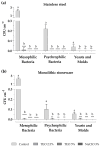Eco-Friendly Sanitization of Indoor Environments: Effectiveness of Thyme Essential Oil in Controlling Bioaerosol Levels and Disinfecting Surfaces
- PMID: 38804294
- PMCID: PMC11130963
- DOI: 10.3390/biotech13020012
Eco-Friendly Sanitization of Indoor Environments: Effectiveness of Thyme Essential Oil in Controlling Bioaerosol Levels and Disinfecting Surfaces
Abstract
Bioaerosols and pathogens in indoor workplaces and residential environments are the primary culprits of several infections. Techniques for sanitizing air and surfaces typically involve the use of UV rays or chemical sanitizers, which may release chemical residues harmful to human health. Essential oils, natural substances derived from plants, which exhibit broad antimicrobial properties, could be a viable alternative for air and surface sanitation. The objective of this study has been to investigate the efficacy of thyme essential oil (TEO) in environmental sanitation processes. In Vitro assays through agar well diffusion, disk volatilization and tube dilution methods revealed significant antimicrobial activity of TEO 100% against foodborne and environmental isolates, with both bacteriostatic/fungistatic and bactericidal/fungicidal effects. Therefore, aqueous solutions of TEO 2.5% and 5% were formulated for air sanitation through nebulization and surface disinfection via direct contact. Bioaerosol samples and surface swabs were analyzed before and after sanitation, demonstrating the efficacy of aqueous solutions of TEO in reducing mesophilic and psychrophilic bacteria and environmental fungi levels in both air and on surfaces. The obtained results prove the antimicrobial potential of aqueous solutions of TEO in improving indoor air quality and surface cleanliness, suggesting thyme essential oil as an effective and safe natural sanitizer with minimal environmental impact compared to dangerous chemical disinfectants.
Keywords: antimicrobial activity; bioaerosol control; indoor sanitization; surface disinfection; thyme essential oil.
Conflict of interest statement
The authors declare no conflicts of interest.
Figures



Similar articles
-
Antibacterial and Antibiofilm Efficacy of Thyme (Thymus vulgaris L.) Essential Oil against Foodborne Illness Pathogens, Salmonella enterica subsp. enterica Serovar Typhimurium and Bacillus cereus.Antibiotics (Basel). 2023 Feb 28;12(3):485. doi: 10.3390/antibiotics12030485. Antibiotics (Basel). 2023. PMID: 36978352 Free PMC article.
-
Physical and antibacterial properties of açaí edible films formulated with thyme essential oil and apple skin polyphenols.J Food Sci. 2014 May;79(5):M903-10. doi: 10.1111/1750-3841.12432. Epub 2014 Apr 17. J Food Sci. 2014. PMID: 24749789
-
Thyme and Oregano Oil Potential Therapeutics against Malathion Toxicity through Biochemical, Histological, and Cytochrome P450 1A2 Activities in Male Wistar Rats.Animals (Basel). 2024 Oct 9;14(19):2914. doi: 10.3390/ani14192914. Animals (Basel). 2024. PMID: 39409863 Free PMC article.
-
Antifungal properties of essential oils for improvement of indoor air quality: a review.Rev Environ Health. 2018 Mar 28;33(1):63-76. doi: 10.1515/reveh-2017-0023. Rev Environ Health. 2018. PMID: 29077554 Review.
-
Antifungal activity and mechanism of action of natural product derivates as potential environmental disinfectants.J Ind Microbiol Biotechnol. 2023 Feb 17;50(1):kuad036. doi: 10.1093/jimb/kuad036. J Ind Microbiol Biotechnol. 2023. PMID: 37951298 Free PMC article. Review.
Cited by
-
In Vitro Biological Activities of Paederia grandidieri Leaf Extracts.Int J Mol Sci. 2024 Dec 2;25(23):12960. doi: 10.3390/ijms252312960. Int J Mol Sci. 2024. PMID: 39684671 Free PMC article.
References
-
- Imperatore R., Pagliarulo C., Orso G., De Cristofaro G.A., Sateriale D., Paolucci M. Olive Mill Wastewater Bioactive Molecules: Applications in Animal Farming BT. In: Souabi S., Anouzla A., editors. Wastewater from Olive Oil Production: Environmental Impacts, Treatment and Valorisation. Springer International Publishing; Cham, Switzerland: 2023. pp. 107–141.
-
- Sateriale D., Forgione G., Di Rosario M., Pagliuca C., Colicchio R., Salvatore P., Paolucci M., Pagliarulo C. Vine-Winery Byproducts as Precious Resource of Natural Antimicrobials: In Vitro Antibacterial and Antibiofilm Activity of Grape Pomace Extracts against Foodborne Pathogens. Microorganisms. 2024;12:437. doi: 10.3390/microorganisms12030437. - DOI - PMC - PubMed
-
- Sateriale D., Imperatore R., Colicchio R., Pagliuca C., Varricchio E., Volpe M.G., Salvatore P., Paolucci M., Pagliarulo C. Phytocompounds vs. Dental Plaque Bacteria: In Vitro Effects of Myrtle and Pomegranate Polyphenolic Extracts Against Single-Species and Multispecies Oral Biofilms. Front. Microbiol. 2020;11:592265. doi: 10.3389/fmicb.2020.592265. - DOI - PMC - PubMed
-
- Orso G., Solovyev M.M., Facchiano S., Tyrikova E., Sateriale D., Kashinskaya E., Pagliarulo C., Hoseinifar H.S., Simonov E., Varricchio E., et al. Chestnut Shell Tannins: Effects on Intestinal Inflammation and Dysbiosis in Zebrafish. Animals. 2021;11:1538. doi: 10.3390/ani11061538. - DOI - PMC - PubMed
Grants and funding
LinkOut - more resources
Full Text Sources
Molecular Biology Databases
